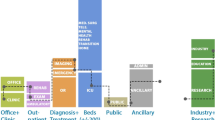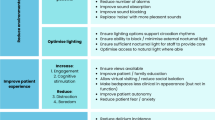Abstract
A growing trend in healthcare is the notion of Acuity-Adaptable care /Universal Care patient room that is compelling hospitals to abandon the traditional approach to care where patients are transferred from unit to unit in search of the proper level of care with negative effects on healthcare quality. This paper reviews key design elements that support the success of an Acuity-Adaptable care /Universal care patient room, in particular, focusing on design solutions that attempt to adapt the patient room to the pathology level through the position of the ‘life support system’; balancing technological complexities with the human dimension; improving the organization of the staff’ work through the decentralization nurse stations.
Access this chapter
Tax calculation will be finalised at checkout
Purchases are for personal use only
Similar content being viewed by others
References
Hendrich, A.L., Fay, J., Sorrells, A.K.: Effects of acuity-adaptable rooms on flow of patients and delivery of care. Am. J. Crit. Care 13(1), 35–45 (2004)
Hendrich, A.L., Lee, N.: Intra-unit patient trasnports: time, motion, and cost impact on hospital efficiency. Nurs. Econ. 23(4), 157–164 (2005)
Eveillard, M., Quenon, J.-L., Rufat, P., Mangeol, A., Fauvelle, F.: Association between hospital-acquired infections and patients’ transfers. Infect. Control Hosp. Epidemiol. 22(11), 693–696 (2001)
Szem, J.W., Hydo, L.J., Fischer, E., Kapur, S., Klemperer, J., Barie, P.S.: High-risk intrahospital transport of critically ill patients: safety and outcome of the necessary “road trip.” Crit. Care Med. 23(10), 1660–1666 (1995)
Taylor, J.O., Landers, C.F., Chulay, J.D., Hood, W.B., Abelmann, W.H.: Monitoring high-risk cardiac patients during transportation in hospital. Lancet 2, 1205–1208 (1970)
Brown, K.K., Gallant, D.: Impacting patient outcomes through design: acuity adaptable care/universal room design. Crit. Care Q. 29(4), 326–341 (2007)
Ulrich, R., Zhu, X.: Medical complications of intra-hospital patient transports: implications for architectural design and research. Health Environ. Res. Des. J. 1(1), 31–43 (2007)
Hurst, J.M., Davis, K., Johnson, D.J., Branson, R.D., Campbell, R.S., Branson, P.S.: Cost and complications during in hospital transport of critically ill patients: a prospective cohort study. J. Trauma 33(4), 582–585 (1992)
Brown, K.K.: The universal bed care delivery model, facility design and operations combine to impact the patient experience. In: Patient Safety & Quality Healthcare (2007). http://psqh.com/marapr07/caredelivery.html
Hendrich, A.: Case study: the impact of acuity adaptable rooms on future designs, bottlenecks and hospital capacity. In: Impact Conference on Optimizing the Physical Space for Improved Outcomes, Satisfaction and the Bottom Line, Atlanta, Georgia (2003)
Gallant, D.: Streamlining patient care processes through flexible room and equipment design. Crit. Care Nurs. Q. 24(3), 59–76 (2001)
Pati, D., Evans, J., Waggener, L., Harvey, T.: An exploratory examination of medical gas booms versus traditional headwalls in intensive care unit design. Crit. Care Nurses Q. 31(4), 340–356 (2008)
Hamilton, D.K., Ulrich, R.S.: Evidence-based design of the cardiothoracic critical care. In: Klein, A., Vuylsteke, A., Nashef, S.A.M. (eds.) Core topics in cardiothoracic critical care, pp. 468–474. Cambridge University Press, England (2008)
Needham, D.M., Sinopoli, D.J., Thompson, D.A., et al.: A system factors analysis of line, tube and drain incidents in the intensive care unit. Crit. Care Med. 33(8), 1701–1707 (2005)
Jacobs Medical Center in San Diego. http://www.cannondesign.com/
Breslow, M.J., et al.: Effect of a multiple-site intensive care unit telemedicine program on clinical and economic outcomes: an alternative paradigm for intensivist staffing. Crit. Care Med. 32(1), 31–38 (2004)
Thomas, E.J., et al.: Association of telemedicine for remote monitoring of intensive care patients with mortality, complications, and length of stay. J. Am. Med. Assoc. 302, 2671–2678 (2009)
Ferrante, T.: Valutare la qualità percepita. Uno studio pilota per gli hospice, Evaluation of perceived quality. Hospice: a pilot study. FrancoAngeli, Milano (2013)
Ferrante, T.: EBD&EBM: qualità degli spazi & qualità delle cure. In: Ergonomia, no. 15 (2017)
Harris, D., et al.: The impact of single family room design on patients and caregivers: executive summary. J. Perinatol. 26(3), 38–48 (2006)
Pati, D., Harvey, T., Thurston, T.: Estimating design impact on waste reduction: examining decentralized nursing. J. Nurs. Adm. 42(11), 513–518 (2012)
Gurascio-Howard, L., Malloch, K.: Centralized and decentralized nurse station design: an examination of caregiver communication, work activities, and technology. Health Environ. Res. Des. J. 1, 44–57 (2007)
Zborowsky, T., et al.: Centralized vs. decentralized nursing stations: effects on nurses’ functional use of space and work environment. Health Environ. Res. Des. J. 3, 19–42 (2010)
Kobus, R.L., Russ W.: Designing for Safety. In: Healthcare Design (2010)
Acknowledgments
Author Contributions: Conceptualization, Data curation, Investigation, Cristiana Cellucci; Supervision, Validation, Tiziana Ferrante. Writing—original draft, Cristiana Cellucci; Writing—review & editing, Tiziana Ferrante, Cristiana Cellucci.
Author information
Authors and Affiliations
Corresponding author
Editor information
Editors and Affiliations
Rights and permissions
Copyright information
© 2021 The Author(s), under exclusive license to Springer Nature Switzerland AG
About this paper
Cite this paper
Ferrante, T., Cellucci, C. (2021). Improving the Patient Room: Lessons from Acuity Adaptable Room. In: Kalra, J., Lightner, N.J., Taiar, R. (eds) Advances in Human Factors and Ergonomics in Healthcare and Medical Devices. AHFE 2021. Lecture Notes in Networks and Systems, vol 263. Springer, Cham. https://doi.org/10.1007/978-3-030-80744-3_19
Download citation
DOI: https://doi.org/10.1007/978-3-030-80744-3_19
Published:
Publisher Name: Springer, Cham
Print ISBN: 978-3-030-80743-6
Online ISBN: 978-3-030-80744-3
eBook Packages: EngineeringEngineering (R0)




